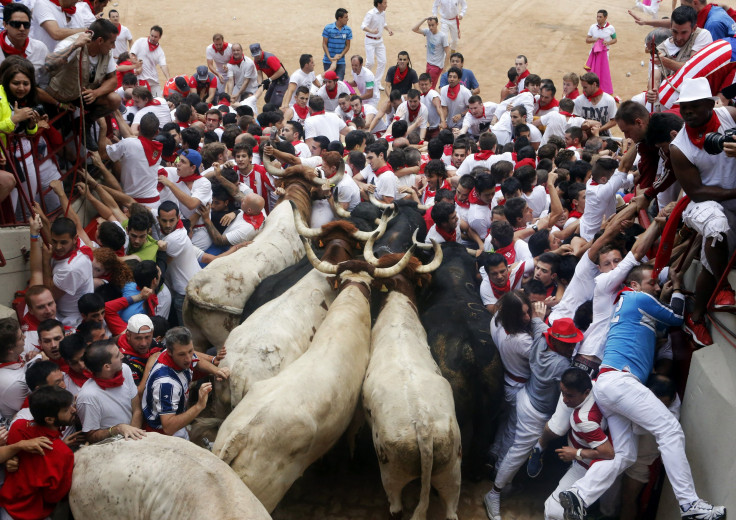‘The Great Bull Run’ Brings Death-Defying Spanish Tradition To 10 US Cities

Rob Dickens has been trying to make it to Pamplona for the annual running of the bulls for several years, but when time constraints and money kept him away time and again, he came up with an idea: Instead of traveling to Spain for a bull run, why not bring bull runs to the U.S. The Great Bull Run LLC was born.
Starting this month, a group of running bulls and trainers will circle the U.S. like a traveling rodeo, setting up shop in 10 cities from Florida to California through July 2014 under the banner of the Great Bull Run.
First up is Richmond, Va., where the Aug. 24 run at a drag-racing strip south of the city has already attracted 5,000 participants and an additional 4,000 spectators. The Atlanta event on Oct. 19, meanwhile, currently has 2,000 runners and another 1,000 spectators. Chief Operating Officer Dickens said he gets about 250 additional registrations each day and has around 20,000 people nationwide who’ve signed the necessary waivers that enable them to participate.
Unlike its weeklong, alcohol-infused Spanish precursor -- made famous by author Ernest Hemingway’s “The Sun Also Rises” -- Dickens said the U.S. version would be a one-day event in each host city. Moreover, he noted that the company had put in place several steps to reduce the risk of serious injuries and create a safer environment for both the bulls and humans.
“First, we won’t be using hyperaggressive fighting bulls that have been trained to seek out and gore humans on sight, nor will we be filing the bulls’ horns to razor-sharp points. Second, we run only on dirt or grass, not slippery cobblestones, in order to prevent the slips and falls that often injure bulls in Spain. Similarly, our courses don’t utilize sharp turns that bulls can’t navigate, which in Spain often leads to pileups of bulls and humans. Third, our courses aren’t walled in by buildings, leaving runners with no possible escape route.”
Instead, the Great Bull Run will construct the track using rodeo fencing that it says runners can easily climb over to get out of the way of a charging bull. The company has also designed nooks in the fencing that it claims will allow runners to sidestep incoming danger. Yet, as the website points out, “by participating in the run, you accept the risk that you might be trampled, gored, rammed or tossed in the air by a bull, or bumped, jostled, tripped or trampled by your fellow runners."
Dickens said, “Any serious injury or death will certainly get people talking, but everyone understands that there are inherent risks involved in running with the bulls. That's what draws people to it.”
He noted that some politicians or activists may attempt to take advantage of an injury to get some media coverage, “but at the end of the day, running with the bulls isn’t more dangerous than skydiving, bungee jumping or riding a motorcycle, and we haven’t banned those activities.”
Last month in Pamplona, an American college student and a young Australian woman were both gored and seriously injured while running with the bulls. Video footage of a Spaniard tossed around like a rag doll by a bull also made headlines around the world.
Dickens, who believes running with bulls could become the next big extreme sport, claims there have been 44,000 motorcycling deaths in the U.S. in the past 10 years and just 15 deaths in Pamplona over the past 103 years, though comparisons like this between a daily activity and a yearly event are sure to come under scrutiny.
What’s also likely to come under scrutiny is the treatment of the animals, and the Great Bull Run LLC has publicized its stance on animal rights in an effort to skirt the all but certain outcry from activists.
The company said that animals will be kept on a “free-range ranch” when they aren't at an event; they won't be abused, hit, shocked or deprived of food; a veterinarian will be onsite at all times to monitor their health and treatment; and the bulls will be acclimated to crowds and the arena prior to each race to reduce any stress.
Finally, while the running of the bulls at the San Fermin Festival in Pamplona concludes with a bullfight and the death of each racing animal, every Great Bull Run will conclude with a “Tomato Royale,” an event that draws inspiration from yet another Spanish festival: Buñol’s La Tomatina. As such, no bulls will be killed at the end of each event. The company can't offer the same guarantee, however, for the human participants.
© Copyright IBTimes 2024. All rights reserved.






















